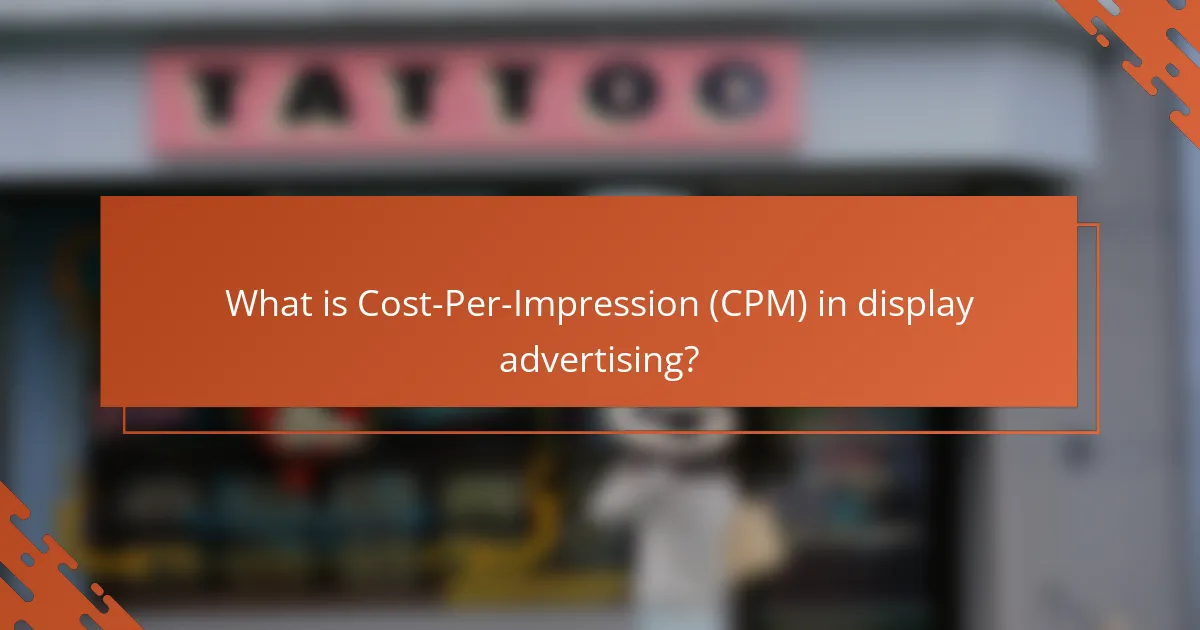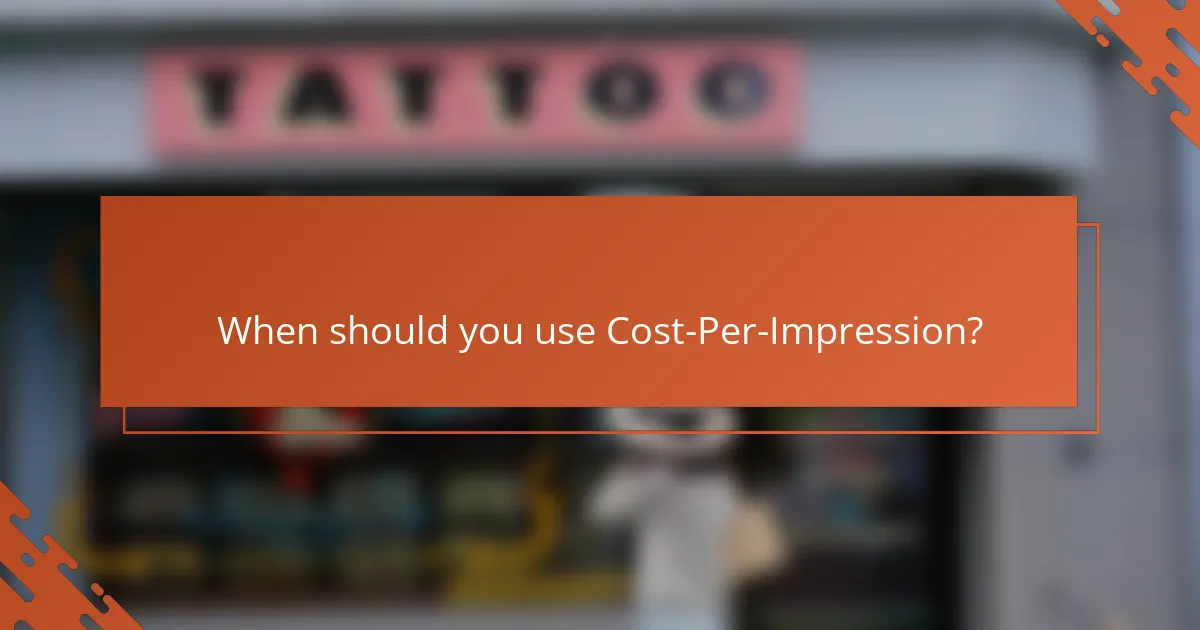Understanding the differences between Cost-Per-Click (CPC) and Cost-Per-Impression (CPM) is crucial for optimizing your advertising strategy. CPC focuses on driving traffic by charging advertisers only when users click on their ads, making it ideal for lead generation. In contrast, CPM emphasizes ad visibility and is better suited for brand awareness campaigns, charging for every thousand impressions regardless of user interaction. Choosing the right model depends on your specific marketing goals and desired outcomes.

What is Cost-Per-Click (CPC) in display advertising?
Cost-Per-Click (CPC) is a pricing model in display advertising where advertisers pay each time a user clicks on their ad. This approach allows advertisers to only incur costs when their ads generate actual engagement, making it a popular choice for driving traffic to websites.
CPC definition
CPC refers to the amount an advertiser pays for each click on their ad. This model is commonly used in online advertising, particularly in search engines and social media platforms. Advertisers set a maximum bid for how much they are willing to pay per click, which can influence ad placement and visibility.
How CPC works
CPC operates through an auction system where advertisers bid for ad placements. When a user searches for a relevant term or visits a site, the platform evaluates bids and ad quality to determine which ads to display. The actual cost per click may vary based on competition and the ad’s performance, often resulting in costs that are lower than the maximum bid.
For example, if an advertiser bids $1.00 per click but the competition is low, they may end up paying only $0.50 for each click. This dynamic pricing encourages advertisers to optimize their ads for better performance to reduce costs.
Benefits of using CPC
One of the main benefits of using CPC is that it allows advertisers to control their spending by paying only for actual clicks. This model can lead to a higher return on investment (ROI) since costs are directly tied to user engagement. Additionally, CPC campaigns can be easily tracked and adjusted based on performance metrics.
Another advantage is the ability to target specific audiences effectively. Advertisers can tailor their ads to reach users who are more likely to click, improving the chances of conversions. However, it is essential to monitor click quality, as high click rates do not always translate to successful outcomes.

What is Cost-Per-Impression (CPM) in display advertising?
Cost-Per-Impression (CPM) is a pricing model in display advertising where advertisers pay for every thousand impressions their ads receive. This model focuses on the visibility of the ad rather than direct interactions, making it suitable for brand awareness campaigns.
CPM definition
CPM stands for Cost-Per-Mille, with “mille” meaning thousand in Latin. In this model, advertisers are charged a set fee for every one thousand times their ad is displayed, regardless of whether users click on the ad. This approach is often used in digital marketing to measure the cost-effectiveness of ad placements.
How CPM works
CPM operates by calculating the total cost of an ad campaign based on the number of impressions. For example, if an advertiser sets a CPM rate of $5, they will pay $5 for every 1,000 impressions their ad receives. Advertisers typically set a budget and bid for ad placements on various platforms, which then serve the ads based on the target audience.
To implement a CPM strategy, advertisers should consider their target audience and the platforms where their ads will be displayed. They can use tools to track impressions and adjust their campaigns based on performance metrics, ensuring they maximize visibility while staying within budget.
Benefits of using CPM
One of the primary benefits of using CPM is its effectiveness for brand awareness campaigns. Since advertisers pay for visibility, they can reach a larger audience without needing immediate engagement. This is particularly useful for new product launches or rebranding efforts.
Additionally, CPM can be more cost-effective for campaigns focused on impressions rather than clicks. Advertisers can often secure lower rates for high-traffic sites, allowing them to reach a broader audience at a lower cost per impression. However, it’s essential to monitor the campaign’s performance to ensure the impressions translate into brand recognition and potential conversions.

When should you use Cost-Per-Click?
Cost-Per-Click (CPC) is ideal when your primary goal is to drive traffic to your website and generate leads or sales. This model charges you only when a user clicks on your ad, making it a performance-based approach that can yield high returns if managed correctly.
Best scenarios for CPC
CPC is most effective for campaigns focused on specific actions, such as signing up for a newsletter or making a purchase. It works particularly well for e-commerce businesses that want to attract customers ready to buy, as well as for lead generation in service-based industries.
Additionally, CPC is beneficial when you have a clear understanding of your conversion rates and can calculate the maximum cost you are willing to pay per click. This allows you to optimize your budget effectively and maximize your return on investment.
Target audience considerations
When using CPC, it’s crucial to define your target audience accurately. Understanding their online behavior and preferences helps you create compelling ads that resonate with them, increasing the likelihood of clicks and conversions.
Consider factors such as demographics, interests, and online habits. For instance, if your audience is primarily young adults, platforms like Instagram or TikTok may be more effective for your CPC campaigns than traditional search engines.

When should you use Cost-Per-Impression?
Cost-Per-Impression (CPM) is ideal when your goal is to maximize visibility rather than immediate clicks. This model is particularly effective for campaigns focused on brand exposure, where the aim is to reach a large audience efficiently.
Best scenarios for CPM
CPM works best in scenarios where brand visibility is crucial, such as during product launches or major marketing campaigns. It is particularly effective on platforms with high traffic, allowing advertisers to reach thousands of potential customers quickly.
Consider using CPM when targeting broad demographics or when the ad content is visually engaging, as this can enhance the likelihood of impressions translating into brand recognition. Additionally, if you have a limited budget but want to achieve significant reach, CPM can be a cost-effective choice.
Brand awareness objectives
When the primary objective is to build brand awareness, CPM is a strong option. This model allows advertisers to showcase their brand to a wide audience, making it suitable for campaigns that aim to create familiarity and recognition.
For instance, if a company is launching a new product, using CPM can help ensure that the ad is seen by as many people as possible, even if they do not click through immediately. This approach is particularly valuable in competitive markets where standing out is essential.

How do CPC and CPM compare?
CPC (Cost-Per-Click) and CPM (Cost-Per-Thousand Impressions) are two distinct pricing models in online advertising. CPC charges advertisers for each click on their ad, while CPM charges based on the number of impressions, or views, the ad receives. Choosing between them depends on campaign goals and target audience engagement.
CPC vs. CPM cost analysis
When analyzing costs, CPC is often more suitable for campaigns focused on driving traffic and conversions, as you only pay when a user clicks on your ad. In contrast, CPM is beneficial for brand awareness campaigns where visibility is the priority, allowing advertisers to pay for exposure rather than direct engagement.
For example, if a CPC campaign costs around $1 to $3 per click, a CPM campaign might range from $2 to $10 per thousand impressions. Understanding your budget and objectives will help you determine which model aligns better with your advertising strategy.
Performance metrics comparison
Performance metrics differ significantly between CPC and CPM. CPC campaigns typically emphasize click-through rates (CTR) and conversion rates, as these metrics directly measure user engagement and effectiveness. A higher CTR indicates that the ad resonates well with the audience.
On the other hand, CPM campaigns focus on impressions and reach. Metrics such as cost per acquisition (CPA) can also be relevant, as they measure the cost-effectiveness of converting impressions into actual sales or leads. Evaluating these metrics will guide you in optimizing your advertising efforts based on your specific goals.

What factors influence the choice between CPC and CPM?
The choice between Cost-Per-Click (CPC) and Cost-Per-Impression (CPM) depends on various factors, including your campaign goals and budget constraints. Understanding these elements can help you select the most effective pricing model for your advertising strategy.
Campaign goals
Your campaign goals play a crucial role in determining whether to use CPC or CPM. If your objective is to drive traffic to your website and encourage user engagement, CPC may be more suitable as you only pay when someone clicks on your ad. Conversely, if your aim is to increase brand awareness and visibility, CPM could be more effective since you pay for every thousand impressions, regardless of clicks.
For example, a brand launching a new product may prioritize impressions to build recognition, opting for CPM. In contrast, an e-commerce site looking to boost sales might favor CPC to ensure they only pay for actual visits to their site.
Budget constraints
Budget constraints significantly influence the choice between CPC and CPM. If you have a limited budget and want to maximize your return on investment, CPC can be advantageous as it allows you to control costs by only paying for actual clicks. This model can help you allocate funds more effectively, especially if you are targeting a specific audience.
On the other hand, if your budget allows for broader reach and you aim for high visibility, CPM can be a better option. It enables you to secure a larger number of impressions, which can be beneficial for campaigns focused on brand awareness. Consider your overall advertising budget and how much you are willing to spend per click or per impression to make the best choice.

What are the emerging trends in CPC and CPM?
Emerging trends in Cost-Per-Click (CPC) and Cost-Per-Impression (CPM) indicate a shift towards more data-driven advertising strategies. Advertisers are increasingly leveraging advanced analytics and machine learning to optimize their campaigns, leading to more efficient spending and better targeting.
Increased Focus on Audience Targeting
Advertisers are prioritizing precise audience targeting to maximize the effectiveness of both CPC and CPM campaigns. By utilizing data analytics, businesses can segment their audiences based on behavior, demographics, and interests, ensuring that their ads reach the most relevant users. This targeted approach often results in higher engagement rates and improved return on investment.
For example, a company selling outdoor gear might focus its CPC campaigns on users who have recently searched for hiking trails or camping equipment, rather than a broader audience. This can lead to more clicks from interested consumers, ultimately enhancing conversion rates.
Shift Towards Programmatic Advertising
Programmatic advertising is gaining traction, allowing for automated buying and selling of ad space. This trend is particularly relevant for CPM campaigns, where advertisers can bid for impressions in real-time based on audience data. This automation not only streamlines the process but also helps advertisers optimize their budgets more effectively.
With programmatic advertising, businesses can adjust their strategies on the fly, responding to real-time data and trends. For instance, if a particular ad is performing well, advertisers can allocate more budget to that campaign while reducing spend on less effective ads.
Emphasis on Multi-Channel Strategies
There is a growing emphasis on multi-channel advertising strategies that integrate both CPC and CPM models. By combining these approaches, advertisers can enhance their visibility and engagement across various platforms, from social media to search engines. This holistic strategy allows for a more comprehensive reach and can lead to increased brand awareness.
For instance, a brand might use CPM to build awareness through display ads while simultaneously running CPC campaigns on search engines to capture intent-driven traffic. This dual approach can create a synergistic effect, driving both immediate clicks and long-term brand recognition.
